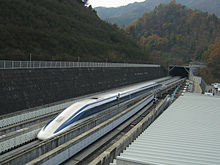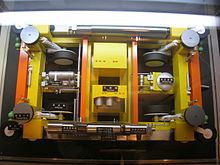JR Maglev

The Japanese JR -Maglev is a 1997 gone into test mode magnetic levitation ( mag netic Lev itation). Experimental trains MLX01 and series-ready trains L0 operate . The 43 km long test track in Yamanashi Prefecture will be part of a 500 km / h connection between the cities of Tokyo and Osaka over the next few decades .
The JR-Maglev is an electrodynamic levitation system (EDS) with the following special features: It is not the train that encompasses the route, but the trough-shaped route that includes the train. Large, ironless , superconducting coils in the trains allow a large air gap in the route. Normally conducting coils on its side walls are shaped and connected in such a way that currents are only induced in them to the extent that the train deviates from a symmetrical position. Behind these coils is the three-phase excited long stator for driving and braking.
In 2014, the state-owned Japan Bank for International Cooperation (JBIC) granted the US consortium Baltimore-Washington Rapid Rail a low-interest loan of five billion dollars as start-up financing for what investors believe will be the first section of a connection from Washington, DC to New York city . The route is still open (as of 2019).
Development history
In the course of the development of magnetic levitation technology in Japan, the coil arrangement changed several times. The constant feature was and is the equipping of the vehicles with superconducting, short-circuited magnetic coils in bath cryostats .
RTRI
From 1972, the first vehicle, LSM200, at the Railway Technical Research Institute (RTRI) was used exclusively for testing the drive . It was still on wheels and encompassed the long stator, which protruded from the middle of the roadway as a bridge. Its traveling magnetic field took the vehicle with it without slipping, see linear motor .
From 1974 onwards, the ML100A was the first electrodynamic vehicle to float at the RTRI. The track now had additional passive, normally conductive coils in the horizontal surfaces to the right and left of the stator. The currents necessary for electrodynamic levitation were induced in it when driving quickly.
Maglev test track in Miyazaki
The first larger test track of this type was built in 1977 in Miyazaki Prefecture and was expanded to a length of around 7 km by 1979. The vehicle on this route, the ML-500, was 13 m long, had a mass of 10 t and was unmanned. It set a speed record in December 1979 with 517 km / h .
Then a trough-shaped guideway profile without a walkway was used in favor of a more compact vehicle cross-section that is more suitable for passenger transport. This was removed on a 2 km long section of the test track and the coils of the long stator inside it were mounted on the side walls of the guideway.
So that these coils could serve not only for the drive but also for tracking purposes, they were interconnected in pairs underneath the vehicle in such a way that the electrodynamically induced voltages were compensated for when the vehicle was in the middle ( zero-flux coils ), but resetting currents resulted when the vehicle was deflected sideways. From 1980 the 29 m long, 30 t heavy, three-part train MLU001 drove on this route. Each car had four vertically oriented, superconducting coils in both side walls, which interacted with both the vertical and the horizontal coils in the guideway. Was examined z. B. the dynamic stability of coupled cars and the effect of the hydraulically deployable airbrakes.

In another vehicle, the MLU002, built in 1987, the coils were no longer distributed over the length of the vehicle, but attached to two bogies, so that the 22 m long single wagon could still come through the curve. The trains had 32 and 44 seats respectively. This vehicle burned out and was replaced by MLU002N. A major innovation was a suspension between the coil carrier and the bogie in addition to that between the bogie and the car body. All three trains reached around 400 km / h, limited by the length of the route.
Yamanashi Maglev Test Line (YMTL)
A more practical route, two-lane, with a tunnel share of 90% and gradients of up to 40 ‰, was built from 1990 to 1996 in the urban areas of Ōtsuki and Tsuru in Yamanashi Prefecture , west of Tokyo . The line, initially 18 km in length, was renewed between 2011 and 2013 and expanded to 42.8 km and is to be part of a commercial line Tokyo - Osaka , see Chūō-Shinkansen . Since 1997, test drives with different configurations have been carried out on the route.
On October 3, 1997, the first three-section test train, MLX01, reached a speed of 451 km / h, on December 12, 531 km / h, and April 14, 1999, 552 km / h. After previous unmanned test drives with up to 575 km / h, the vehicle MLX01 set a new world speed record for rail vehicles on December 2, 2003 with a speed of 581 km / h. To reach this speed, the vehicle needed 92 seconds from a standstill (0 km / h) and covered 8,800 meters. For comparison, the ICE3 (half-train) needs 324 seconds from 0 to 300 km / h and the Transrapid 08 for the same speed of 300 km / h from a standstill 98 seconds.
Due to the short test route, the speed during the record run could only be maintained for 5 seconds before the vehicle had to brake again. For this it took 167 seconds to come to a complete standstill. The vehicle covered a total of 17.8 km in 4.4 minutes.
Since the commissioning of the second four-section test train, the MLX01, in 1998 there have been regular high-speed encounter drives. In November 2004, a new world record was set with two trains traveling in opposite directions with an encounter speed of 1026 km / h . One of the two trains drove at 575 km / h. By October 2004, a total of over 400,000 kilometers had been covered on the route and 80,000 visitors were taken along.
In 2013, the first L0 series vehicle was delivered for testing. This made further records possible, the last two record speeds in test operation of 590 km / h and a few days later even 603 km / h come from April 2015.
Public traffic
The end section MLX01-1 was retired and replaced by the aerodynamically improved MLX01-901. The decommissioned section could be seen as an information center during Expo 2005 in Nagoya . The test track has been open to the public since 2000. An information center, a museum and a new platform were built for this purpose. Originally, a ride was also possible, the maximum operating speed was limited to 501 km / h. The number of interested parties exceeded the quota of tickets by around ten times. According to a telephone call in July 2010 at the YAMANASHI Laboratory, the ride-sharing option was terminated in 2007, while the test runs could still be viewed. In the same year, however, JR Central was planning to reintroduce the interrupted public demonstration drives on weekends and during the vacation period in 2013 and beyond when the route extension was completed.
Currently (as of October 2018) rides are possible again, but the places for them will be raffled. Only those interested in living in Japan can take part in the raffle. Further information on this and on visiting the test track and the "Linear Museum" can be found on the official website (see web links).
Web links
- History of the maglev in Japan
- Maglev in Japan; Transrapid Germany and China (English)
- Up to 500 km / h: Japan builds the first magnetic levitation train connection , Der Spiegel , October 17, 2014
- World's Fastest Train Records Speed of 603 Kilometers Per Hour - Bloomberg Business , April 21, 2015
- "Linear Museum" / Yamanashi Maglev Exhibition Center (English)
Individual evidence
- ↑ JR Central: About the Yamanashi Maglev Line.
- ↑ JL He, DM Rote, HT Coffey: Study of Japanese Electrodynamic-Suspension Maglev Systems. Argonne National Laboratory , 1994, doi: 10.2172 / 10150166 (free full text).
- ↑ Kevin Rector (The Baltimore Sun): Backers of high-speed 'maglev' train to Washington claim $ 5 billion in funding. The Washington Post, Sept. 4, 2014.
- ^ Baltimore – Washington Rapid Rail
- ↑ Hiroshi Seino, Shigeki Miyamoto, Railway Technical Research Institute (RTRI) Qualiti Report Vol. 47 No. 1, Feb. 1, 2006.
- ^ Rainer Schach, Peter Jehle, René Neumann: Transrapid and high wheel-rail high-speed railway - a holistic system comparison. VDI 2006, ISBN 3-540-28334-X , p. 156.
- ^ Railway Technical Research Institute: Overview of Maglev R&D . December 8, 2010.
- ↑ Göttinger Tageblatt
- ↑ linear.jr-central.co.jp ( Memento of the original from March 6, 2010 in the Internet Archive ) Info: The archive link was inserted automatically and has not yet been checked. Please check the original and archive link according to the instructions and then remove this notice.
- ↑ Maglev rides to return from 2013 ( memento of October 24, 2012 in the Internet Archive ), Yomiuri Shimbun, November 26, 2010
- ↑ FAQ of the "Linear Museum" : End of the first section (accessed on March 24, 2019 or personal information in October 2018)




